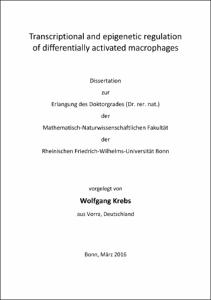Transcriptional and epigenetic regulation of differentially activated macrophages

Transcriptional and epigenetic regulation of differentially activated macrophages

| dc.contributor.advisor | Schultze, Joachim L. | |
| dc.contributor.author | Krebs, Wolfgang | |
| dc.date.accessioned | 2020-04-23T00:36:48Z | |
| dc.date.available | 2020-04-23T00:36:48Z | |
| dc.date.issued | 15.12.2016 | |
| dc.identifier.uri | https://hdl.handle.net/20.500.11811/6925 | |
| dc.description.abstract | Macrophages are an indispensable part of the innate immune system which mediate various functions including host defense against pathogens, metabolism, tissue homeostasis and even developmental processes. These extremely heterogeneous cells can adapt their transcriptional program upon a plethora of stimulatory cues and thus exist in different activation states to facilitate their diverse roles in the body. Corresponding transcriptional changes are established amongst others by transcriptional regulators (TRs) with diverse functions or by complex epigenetic alterations. Next generation sequencing technologies provide excellent experimental methods like ChIP- or RNA-sequencing, with which one can analyze genome wide enrichment properties of DNA binding proteins or the transcriptional activity of genes to elucidate in detail the activation of macrophages on the transcriptional level. Integrating the KO implemented normalization method (KOIN) into the standard peak calling procedure revealed multiple enhancements for ChIP-seq data analysis. False-positive signals can be eliminated in a tremendous amount, while signal-to-noise ratios are increased in low and even high quality ChIP-seq data sets. Besides the identification and removal of a recently identified special type of false-positive signal called “hyper-ChIPable regions”, the biological interpretation can profoundly benefit from KOIN. Overall, the KOIN method demonstrated its value as new possible gold standard control with various advantages compared to the currently established Input chromatin and IgG ChIP-seq controls. Furthermore, the ChIP-seq technology allows the definition of 1) different activity states for promoters or cis-regulatory regions and 2) important regulators in the establishment and maintenance of the transcriptional landscape by the detection of different covalent posttranslational histone modifications (HM), like acetylation or methylation. Four differentially activated primary human macrophages demonstrated a common epigenetic core program, maintained by various promoter sites. Simultaneously, activation state specific epigenetic differences at promoters, super-enhancer regions and especially at enhancer sites could mediate their specialization upon employed stimulatory signals. Finally, despite the detected epigenetic differences an astonishing fraction of genomic loci was defined by accessible promoter and enhancer markings in macrophage activation states. This was especially demonstrated in co-regulation networks for TRs and revealed an uncoupling of epigenetic and transcriptional control in monocyte-derived activated macrophages associated with cellular plasticity in response to microenvironmental signals. Other additional levels of transcriptional fine-tuning like enhancer RNAs, repressor proteins or the cross-talk between HMs could play an important role in fine-tuning macrophage transcription. Especially, the cooperative binding of pioneer transcription factors (TF) like PU.1 with other secondary TFs like STAT proteins to these open genomic macrophage loci could represent an additional important switch in macrophage transcription in concert with HMs. | en |
| dc.language.iso | eng | |
| dc.rights | In Copyright | |
| dc.rights.uri | http://rightsstatements.org/vocab/InC/1.0/ | |
| dc.subject | Aktivierte humane Makrophagen | |
| dc.subject | Transkriptom | |
| dc.subject | Epigenom | |
| dc.subject | Chip-seq | |
| dc.subject | RNA-seq | |
| dc.subject | Histon-Modifikationen | |
| dc.subject | activated human macrophages | |
| dc.subject | transcriptome | |
| dc.subject | epigenome | |
| dc.subject | histone modification | |
| dc.subject.ddc | 570 Biowissenschaften, Biologie | |
| dc.title | Transcriptional and epigenetic regulation of differentially activated macrophages | |
| dc.type | Dissertation oder Habilitation | |
| dc.publisher.name | Universitäts- und Landesbibliothek Bonn | |
| dc.publisher.location | Bonn | |
| dc.rights.accessRights | openAccess | |
| dc.identifier.urn | https://nbn-resolving.org/urn:nbn:de:hbz:5n-45442 | |
| ulbbn.pubtype | Erstveröffentlichung | |
| ulbbnediss.affiliation.name | Rheinische Friedrich-Wilhelms-Universität Bonn | |
| ulbbnediss.affiliation.location | Bonn | |
| ulbbnediss.thesis.level | Dissertation | |
| ulbbnediss.dissID | 4544 | |
| ulbbnediss.date.accepted | 27.10.2016 | |
| ulbbnediss.institute | Mathematisch-Naturwissenschaftliche Fakultät : Fachgruppe Molekulare Biomedizin / Life & Medical Sciences-Institut (LIMES) | |
| ulbbnediss.fakultaet | Mathematisch-Naturwissenschaftliche Fakultät | |
| dc.contributor.coReferee | Kolanus, Waldemar |
Files in this item
This item appears in the following Collection(s)
-
E-Dissertationen (4169)




